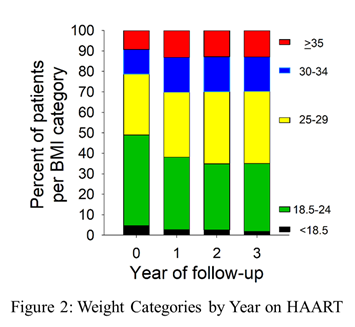Article
INSTI Therapy for HIV Associated with Greater BMI Gains for Blacks, Hispanics, and Women
Author(s):
Race and sex can play a role in the annual BMI gain for patients with HIV who are receiving certain antiretroviral therapy combinations.

Roger Bedimo, MD
Race and sex can play a role in the annual BMI gain for patients with HIV who are receiving certain antiretroviral therapy combinations. Among patients receiving therapy including integrase strand transfer inhibitors, Blacks, Hispanics, and women have higher rates of BMI gains. For women, BMI gains are also higher than men’s for patients taking protease inhibitors.
Investigators, led by Roger Bedimo, MD, of the VA North Texas Health Care System, Dallas, sought to examine the association between highly active antiretroviral therapies (HAART) and BMI changes in patients at a large, urban HIV clinic in Texas.
“While older protease inhibitors (PI) were more likely to lead to central fat accumulation, increases in obesity in people living with HIV following initiation of HAART have been observed with currently used HAART regimens, with greater increases in body mass index (BMI) reported in women and with integrase strand transfer inhibitors (INSTI),” wrote the authors.

Image credit: Roger Bedimo, et al.
The study included 4048 patients with a median follow-up of 6.7 years and a median age of 46.4 years (SD 11.9). Participants’ race/ethnicities were Black (B) (n = 2273; 53.2%), Hispanic (H) (n = 1185; 27.7%), non-Hispanic white (NHW) (n = 689; 16.1%), and other (n = 127; 3.0%). Participants were 1.8% transgender (n = 75), 29.4% women (n = 1257), and 68.9% men (n = 2942). The mean baseline BMI was 27.0 (SD 6.4).
The average BMI changes were significant for Black and Hispanic patients receiving INSTI-based antiretroviral therapy. The yearly BMI change for patients receiving INSTI was .39 for Black patients, .32 for Hispanic patients, and .15 for non-Hispanic White patients (P = .05 for H vs NHW; P = .005 for B vs NHW).
Additionally, BMI increases for women were greater than those for men among patients receiving either PI- or INSTI-based antiretroviral therapy. For patients receiving PI, women’s average annual BMI gain was .33, while for men this was .19 (P = .01). For those receiving INSTI, those BMI gains were .43 and .25, respectively (P = .01).

Image credit: Roger Bedimo, et al.
Finally, the authors noted that the proportion of patients who were overweight or obese, those with a BMI ≥25, increased from 51% at the beginning of antiretroviral therapy to 65% at year 3 of treatment (P <.001).
The poster, “Integrase Inhibitor-Based HAART is Associated with Greater BMI Gains in Blacks, Hispanics and Women,” was presented at ID Week 2018 in San Francisco, CA.
Click here to sign up for more MD Magazine content and updates.
Related Coverage >>>
Opioids Prescribed Twice as Often for Women with HIV Than Men
Opt-Out Testing for HIV, Hepatitis C Could Improve Diagnoses in the ED
INSTI Therapy for HIV Associated with Greater BMI Gains for Blacks, Hispanics, and Women





